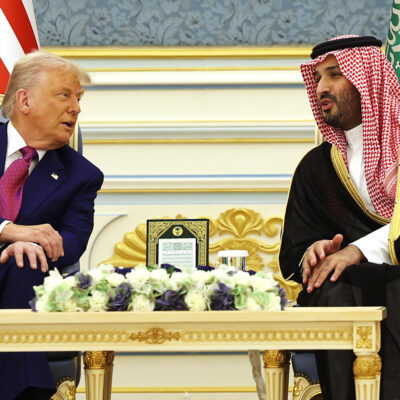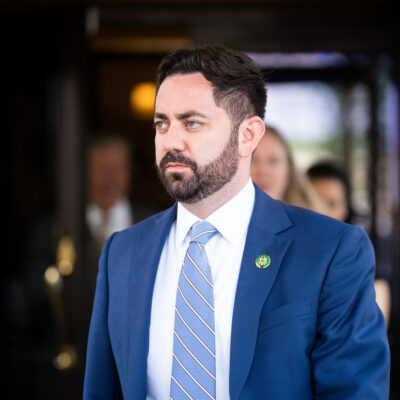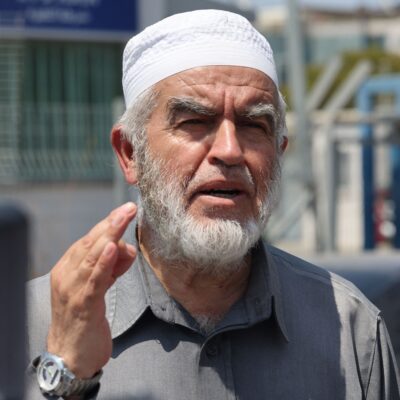
Amir Levy/Getty Images
IDF says more than 12,000 terrorists killed in six months of war, as tensions soar with Iran
Israel and the U.S. are said to be on high alert following last week’s strike in Damascus that killed a top Iranian Revolutionary Guard Corps general
More than 12,000 terrorists have been killed and some 4,600 captured since Israel launched its ground offensive against Hamas in the Gaza Strip, according to statistics shared by the IDF on Sunday – six months to the day after the militant Islamist terror group carried out the worst attack on Israeli soil ever.
The data also showed that 604 Israeli soldiers have been killed in the fighting, about half of them on Oct. 7 when thousands of terrorists led by Hamas’ elite Nukhba forces infiltrated into southern Israel, overpowering army bases, as well as rampaging through towns, villages and a music festival in the area.
With some 300,000 reservist soldiers called up for duty over the past six months, according to the army’s data, on Sunday it said it was pulling most of its ground troops out of southern Gaza for “tactical reasons.” Two brigades will stay in the northern half of the Strip, reports said, in order to “preserve the IDF’s freedom of action and its ability to conduct precise intelligence based-operations.”
Of the terrorists captured over the past six months, the army said in its report that interrogations found that many were complicit in the brutal attacks, which sparked a full-scale IDF ground operation into the Palestinian enclave three weeks later. In its report, the army highlighted that it had succeeded in killing Hamas’ brigade and battalion commanders in northern and central Gaza, as well as top commanders from the Lebanese-based Shia militia Hezbollah, which has been fighting Israel on its northern border.
Israel said Monday that it had killed a senior Hezbollah operative in an airstrike in the area of Sultaniyeh, southern Lebanon. Hezbollah said in a statement Abd al-Amir Hassan Halawi, a top field commander in its Al-Radwan Force, and two other operatives were killed in the overnight strike.
Last week, an air strike in the Syrian capital, Damascus, that was admittedly carried out by Israel, killed Brig. Gen. Mohammad Reza Zahedi, a senior commander in the Iranian Revolutionary Guard Corps, as well as six additional officers including Zahedi’s deputy, prompting fears of an Iranian retaliation either directly on Israel or on a site associated with the Jewish state, or the U.S., in the Middle East.
Reports in U.S. media over the weekend cited a senior administration official as saying that it was on “high alert” and actively preparing for a significant attack by Iran that would target Israeli or American assets in the region within the next week.
On Sunday, a senior Iranian official, Yahya Rahim Safavi, appeared to issue a direct threat on Israeli targets worldwide telling the country’s official ISNA news agency that “The embassies of the Zionist regime are no longer safe.”
Israel increased its alert levels over the weekend, with the army suspending furloughs for all combat units and calling up additional reserve soldiers for its aerial defense forces. The army also announced that it had entered “another phase” of preparedness on the northern front, with logistics in place for a broad mobilization of troops.
A statement Sunday by Israeli Defense Minister Yoav Gallant said that he had held an operational situation assessment with the heads of the army’s operations and intelligence directorates and that Israel is prepared “in the event of any scenario that may develop vis-a-vis Iran.”
“Not attacking from Iranian soil has been the Iranian policy all along,” Menahem Merhavy, a research fellow at Hebrew University’s Truman Institute, told Jewish Insider, adding that Israeli targets worldwide such as embassies or individuals were under threat even before Zahedi was killed.
Last Thursday, widespread disruptions to the country’s satellite navigation systems – which have been scrambled in northern Israel almost since the start of the war – caused traffic jams in central Israel and a murmur of public panic as some Israelis rushed to stock up on water and other supplies, fearing an attack was imminent.
IDF spokesman Rear Adm. Daniel Hagari sought to calm fears in his daily press briefing, explaining that the army had “initiated the GPS disruptions in order to neutralize threats.” He emphasized that this was a “vital and necessary tool in our defensive capabilities.”
While Iran’s supreme leader, Ali Khamenei, issued a threat – in Hebrew – in a post on X a few days after Zahedi’s killing, Menahem Merhavy, a research fellow at Hebrew University’s Truman Institute, told Jewish Insider on Sunday that he did not believe Iran would carry out a direct attack. He did say, however, that it might seek to push its regional proxies — most notably Hezbollah — to ramp up their attacks on Israel.
“Not attacking from Iranian soil has been the Iranian policy all along,” Merhavy, whose area of expertise includes Iran and Islamic movements, said, adding that Israeli targets worldwide such as embassies or individuals were under threat even before Zahedi was killed.
“I don’t think Iran has to do anything about this,” he said, explaining that the Islamic Republic had a great deal of patience and that the targeting of a senior general — in another country — might not necessarily trigger an immediate reaction. By announcing they were on high alert, Merhavy theorized, Israel — and the U.S. — were most likely sending a warning to Iran that they were ready.
In addition, Merhavy said, the Iranian regime is acutely aware that a direct retaliation would likely start a war with Israel that it would lose both militarily and internally, as its legitimacy and popularity with the Iranian people wanes. He also ruled out a cyberattack, saying that Iran was vastly inferior to Israel in that arena.
In terms of Hezbollah, which Israel said had fired more than 30 rockets into its territory on Sunday, Merhavy said the group faced a “hard dilemma.”
“Hezbollah has had its back to the wall in recent months both in terms of Israel and its internal strife in Lebanon,” he explained. “My guess is that they will not go beyond the scope of the fighting that’s been happening for the last six months.”
In the data it shared on Sunday, the IDF said that more than 3,100 rockets, shells and mortars had been fired from Lebanon and Syria into Israeli territory since Oct. 7, most by Hezbollah and some by Hamas-affiliated groups.
From Gaza, the army said, approximately 9,100 rockets had struck inside Israel since the Oct. 7 Hamas attack that killed more than 1,200 people, mostly civilians, and took a further 250 hostage. Around 130 people, including children, women and the elderly, remain captive inside the war-torn enclave. Israel announced on Saturday that commando soldiers had retrieved the body of one hostage, Elad Katzir, 47, who was kidnapped from his home on Kibbutz Nir Oz.
The Hamas-run Gaza Health Ministry estimates that more than 33,000 Palestinians have been killed since the war started, although the terror group does not distinguish between civilians and its fighters. Aid agencies say roughly 1.4 million Gazans have been internally displaced by the fighting, most of them now sheltering in the southern governorate of Rafah, where four Hamas battalions are believed to be dug in along with the terror group’s top leadership.
Although it has been difficult to decipher Israel’s progress in achieving its war aims in Gaza, the IDF information published Sunday said thousands of facilities belonging to the terror group, including rocket launch sites, ammunition storages and its underground infrastructure, had been destroyed.
“When we started, I said this was going to be a long war and that it would take at least a year on the ground in Gaza to do what we need to do, which is eliminate Hamas,” Brig. Gen. (ret.) Jacob Nagel, Israel’s former acting national security adviser and now a senior research fellow at the Washington-based Foundation for Defense of Democracies, told JI. “Hamas as a government, as a military and as an organization has to be eliminated so it cannot repeat what it did on Oct. 7.”
Prime Minister Benjamin Netanyahu added to the information in the weekly cabinet meeting on Sunday, saying in his opening remarks that Israel had “eliminated 19 of Hamas’s 24 battalions, including senior commanders.”
“We have killed, wounded or captured a large number of Hamas terrorists,” he said. “We have cleared out Al-Shifa [Hospital] and other terrorist command centers as well. We have destroyed factories for producing rockets, command centers, and stores of weapons and ammunition, and we are continuing to systematically destroy underground installations. However, the price that we have had to pay has been painful and high.”
Brig. Gen. (ret.) Jacob Nagel, Israel’s former acting national security adviser and now a senior research fellow at the Washington-based Foundation for Defense of Democracies, said that with the exception of southern Gaza, he believed Israeli forces had worked speedily and achieved most of the war’s aims.
“When we started, I said this was going to be a long war and that it would take at least a year on the ground in Gaza to do what we need to do, which is eliminate Hamas,” Nagel told JI. “Hamas as a government, as a military and as an organization has to be eliminated so it cannot repeat what it did on Oct. 7.”
He noted that the IDF had moved through much of Gaza fairly quickly until it reached the southern part of the Strip in February. Nagel also pointed out that Israel’s terrorist to civilian death rate – which he estimated stood at 1-to-1.4 – was relatively low for this type of urban conflict.
“Every dead civilian is a sad fact and Israel doesn’t want to hurt civilians but that is all on Hamas because they use their civilians as human shields,” Nagel emphasized.
He also said that the recent shift in the U.S.’ position on the war was causing Hamas to harden its position even as mediated negotiations for a cease-fire and a hostage release are taking place this week in Egypt.
Hamas’ leader in Gaza, Yahya Sinwar, considered to be the mastermind behind the Oct. 7 attacks, wants a total end to the war and a withdrawal of Israeli forces from the enclave, Nagel said.
“We cannot give him a victory or allow him to remain the leader in Gaza,” he said. “He wants a total surrender and to turn back time to Oct. 6… we cannot do that.”






